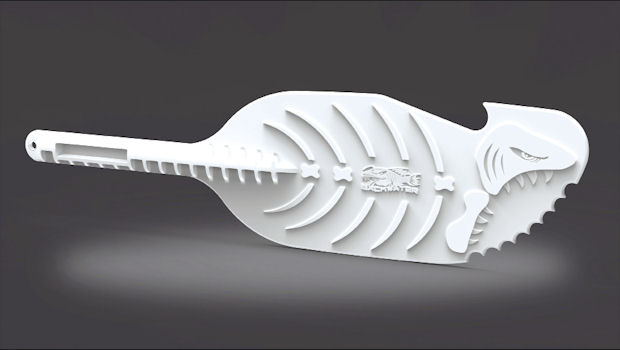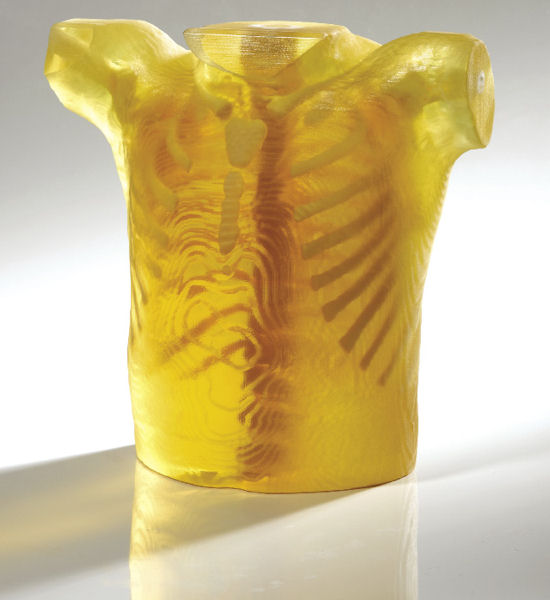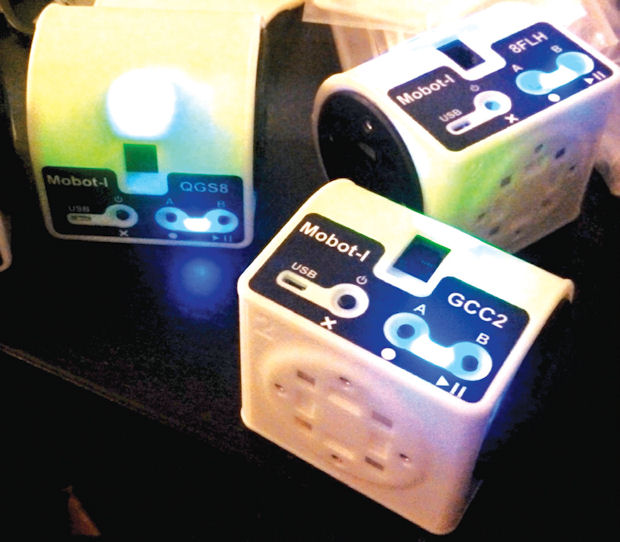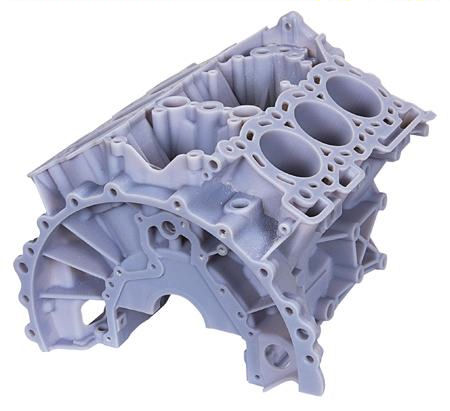Rapid Prototyping’s New Rules of Engagement

The Piranha Paddle was CNC-machined through Proto Labs’ Firstcut Machining Service. The actual size is 21.9 x 5.8 x 0.85 in., and was designed for kayaking through gnarly-swampy areas. Image courtesy of Proto Labs.
Latest News
May 1, 2014
 The Piranha Paddle was CNC-machined through Proto Labs’ Firstcut Machining Service. The actual size is 21.9 x 5.8 x 0.85 in., and was designed for kayaking through gnarly-swampy areas. Image courtesy of Proto Labs.
The Piranha Paddle was CNC-machined through Proto Labs’ Firstcut Machining Service. The actual size is 21.9 x 5.8 x 0.85 in., and was designed for kayaking through gnarly-swampy areas. Image courtesy of Proto Labs.ACIST Medical Systems, a manufacturer of cardiovascular medical device systems, has a fairly extensive set of prototyping capabilities in-house. It maintains an array of medium- to high-end additive manufacturing (AM)/3D printers from a variety of vendors, along with a computer numerically controlled (CNC) milling machine to produce more functional parts. Yet when the engineering group has a requirement to produce multiple iterations of a part or assembly, it frequently turns to an outside prototyping service provider—a design decision meant to aid in expediency and the optimization of limited engineering resources.
“Typically, we do our first-run iterations in-house, mostly for the sake of time and because we want our engineers to interact with the machine shop in a rapid development process,” notes Dave Scott, product development manager at ACIST. The company enlists the RedEye 3D printing service bureau, a business unit of Stratasys, as its prototyping service provider. “The unwritten rule is once we need multiple versions of something, we engage RedEye. It’s as much of a throughput issue and an investment in skills—we appreciate the technology, but it’s better utilization of our time to have RedEye’s expertise managing the creation of those parts.”
 This multi-material prototype, which requires no bonding, is printed as one piece with the skeletal system on the inside (rigid white) and the exterior body printed (rigid amber). Image courtesy of GROWit LLC.
This multi-material prototype, which requires no bonding, is printed as one piece with the skeletal system on the inside (rigid white) and the exterior body printed (rigid amber). Image courtesy of GROWit LLC.Like ACIST, many manufacturers are following a similar design strategy now that less expensive and more functional 3D printers are becoming common fixtures in mid-size and even smaller engineering shops. These printers give design teams the ability to get a basic feel for a part or to explore multiple iterations of a design concept much earlier in the process, without expending significant budget on producing expensive physical prototypes.
Nevertheless, experts say there are limitations to the technology, especially at the stage in the design workflow where functional form and fit is a major priority and when a more realistic representation of the design is required. In addition, in-house prototyping capabilities are often limited in the number and kinds of supported materials, impeding their ability to output a complex part. At the same time, the engineering organization might not have the expertise or the bandwidth to comply with the tight delivery schedules that accompany rapid prototyping.
“With the introduction of lower-cost 3D printers, most of the early concept models and design validation models are being built-in house by the people doing the design work,” notes Terry Wohlers, principal consultant and president at Wohlers Associates, a consultancy specializing in AM, 3D printing and rapid prototyping.
Companies start to seek outside prototyping services when they get to the point where the design is more mature and there’s a need for a full-scale model, an accurate surface finish, or something that needs to be bolted or joined to an assembly, Wohlers explains. “If it’s a functional prototype that might require stronger materials or better accuracy and they don’t have those capabilities in house, that’s typically when they go outside to a provider,” he says.
3D Parts and Beyond
GROWit LLC, which provides rapid prototyping services, built its business on the premise that engineering customers needed two things they couldn’t provide on their own: 3D printing of different materials to accommodate increasingly complex prototypes, and consulting services that go beyond a simple transaction of ordering a part online. That’s according to Ken Burns, who heads up business development for GROWit LLC.
When the Objet Connex multi-material printer was first released in 2007, GROWit LLC decided to be among the first service providers to purchase it and use it as a jumping-off point for differentiation. “So many products in the market are dual-material or require printing of separate components or materials that we saw this as a groundbreaking service,” Burns recalls. “Moreover, while half our customers have 3D printers, even some high-end production ones, they rarely own the full array of technologies that need to be utilized because it just doesn’t make sense.”
With so many materials and AM technologies from which to choose, GROWit LLC helps each client select the right materials and prototyping processes for a particular job. “If a customer doesn’t know what they want in 3D printing or fully understand the capabilities of different materials and the methods for producing those materials, then they are likely to get a bad part and not use us again,” he explains, noting that 75% to 80% of GROWit LLC’s business is comprised of returning customers because “we help them choose the right process and technology based on their specific project.”RedEye is seeing a similar shift in its business model, away from being a pure transactional 3D printing service to more of a consultative engagement in many instances, says Tim Thellin, senior program manager for the firm. Because the service is being used “deeper” in the development process as a way to simulate rubber or project a certain finish, for example, RedEye is spending more time offering consulting services to customers on everything from how to design for AM to how to manipulate CAD files to best fit with Stratasys’ Fused Deposition Modeling (FDM) technology, Thellin says.
At the same time, RedEye is also being engaged beyond prototyping to do pre-production or small production runs. “Say a customer has a product that they produce in high volumes that we’re not capable of running, but they want to get to market as soon as possible,” Thellin explains. “While they’re waiting to get the injection-molded tooling done, they use us for some of the components.”
While previously, just 1% of RedEye’s business was high-quantity orders of more than 25 parts, that figure constitutes about 30% of the company’s revenue today, Thellin says.
Proto Labs, which offers injection molding and CNC machining services, also doesn’t see the influx of low- and mid-range 3D printers as competition, but rather as a complement to the services it provides. While most on-site 3D printers are great for conceptualizing what a part looks like or to create a prop for early design reviews, they aren’t effective for testing function or verifying fit and tolerances.
“We’re where you turn to test a part for load capacity or if its gasket material is holding up well,” explains Gus Breiland, Proto Labs’ customer service engineering manager. “We can put a functioning prototype in the hands of a development team, a user or a small sales team looking to sell the product.”
Product development consultancy Bressler Group has plenty of in-house prototyping muscle, yet it still regularly turns to Prototype Solution Group to provide prototyping services to its customers, in part because of efficiencies, but mostly because as a dedicated prototyping provider, PSG has a breadth of skills and expertise that Bressler lacks. “We don’t do CNC or SLA (stereolithography) [prototypes] in-house because it’s too much for what we want to handle,” says J.D. Albert, Bressler’s director of engineering. “PSG is an expert at making prototypes, and we do it because we need to. Our core competency is design and engineering and figuring out how to get things working.”
Relationship Tips
Bressler and PSG have also figured out the secret to making their engineering services relationship work: Responsiveness and effective communication. Unlike prototyping service bureaus where you exchange a few CAD files and emails regarding quotes, Albert and others say it’s important to regularly communicate and have in-depth discussions upfront about the use case for the prototype parts.
Tom Budd, a partner at PSG, says the company makes it a point to drill down into basic prototyping requirements, including budget and timeframe, well before preparing a quote. “Most problems are a result of a breakdown in communications, where the services provider hasn’t asked enough questions about how the part is to be implemented and the client hasn’t taken the time to explain the program,” he explains. “We try to get inside the customer’s head and listen to what they have for budget and timeframe, which helps dictate what technology we’ll use.”
 Barobo’s Mobot-I is a modular robot with body parts injection molded through Protomold, Proto Labs injection-molding service. Image courtesy of Proto Labs.
Barobo’s Mobot-I is a modular robot with body parts injection molded through Protomold, Proto Labs injection-molding service. Image courtesy of Proto Labs.Responsiveness is another major consideration when choosing a provider, Albert says. “A lot of times, you are counting delivery times by the hour, not day, so that kind of high-level responsiveness is important,” he observes. Also, if it’s not 100% obvious what process to use or what material to employ, it’s critical to be able to talk through those requirements with your service provider, he says: “Deep experience is necessary, along with a combination of responsiveness and openness to trying new things.”
Managing customer expectations, especially because much of the 3D printing technology is still relatively new to some engineering shops, is another important aspect to ensuring a prototyping services partnership works optimally for both parties. While most 3D printer vendors do a great job of showcasing their technology and materials, it’s not always clear what the end result will look like or how much finishing work is necessary to achieve that desired state, according to Matt Hlavin, CEO of rp+m, an engineering and manufacturing services provider.
Helping customers through the learning curve via education and handholding is what sets a true prototyping services experience apart from using turnkey service bureaus, Hlavin says. “While this is a 35-year industry, it’s still in its infancy and the parts are not perfect and the machines don’t run perfectly all the time,” he explains. “People have this notion that they can send a file over and it comes back perfectly all the time. They look at it as a transaction vs. a strategic relationship, and that’s where a lot of the disconnect happens.”
More Info
Subscribe to our FREE magazine, FREE email newsletters or both!
Latest News
About the Author
Beth Stackpole is a contributing editor to Digital Engineering. Send e-mail about this article to [email protected].
Follow DE






